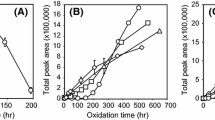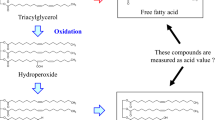Abstract
Acrolein, which is an irritating and off-flavor compound formed during heating of vegetable oils, was estimated by the gas–liquid chromatography (GLC). Several vegetable oils such as high-oleic sunflower, perilla, rapeseed, rice bran, and soybean oils were heated at 180 °C for 480 min and then the concentration of acrolein in the head space gas was determined by GLC. The formation of acrolein was greatest in perilla oil among the tested oils, while it was much lower in rice bran oil and high-oleic sunflower oil. There was a good correlation between the level of acrolein and linolenate (18:3n-3) in the vegetable oils. To investigate the formation of acrolein from linolenate, methyl oleate, methyl linoleate, and methyl linolenate were also heated at 180 °C, and the amounts of acrolein formed from them were determined by GLC. The level of acrolein was the greatest in methyl linolenate. Acrolein was also formed from methyl linoleate, but not from methyl oleate. Acrolein in vegetable oils may be formed from polyunsaturated fatty acids, especially linolenic acid but not from glycerol backbone in triacylglycerols.







Similar content being viewed by others

References
Takeoka G, Perrino C, Buttery R (1996) Volatile constituents of used frying oils. J Agric Food Chem 44:654–660
Gasee FR, Stenhuis WH, Groten JP, Freton VJ (1996) Toxicity of formaldehyde and acrolein mixtures: in vitro studies using nasal epithelial cells. Exp Toxic Pathol 48:481–483
Uchida K (1999) Current status of acrolein as a lipid peroxidation product. Trends Cardiovasc Med 9:109–113
Li L, Holian A (1998) Acrolein: a respiratory toxin that suppresses pulmonary host defense. Rev Environ Health 13:88–108
Faroon O, Roney N, Taylor J, Ashizawa A, Lumpkin MH, Plewak DJ (2008) Acrolein health effects. Toxicol Ind Health 24:447–490
Shi R, Rickwtt T, Sun W (2011) Acrolein-mediated injury in nervous system trauma and diseases. Mol Nutr Food Res 55:1320–1321
Liu XY, Zhu MX, Xie JP (2010) Mutagenicity of acrolein and acrolein-induced DNA adducts. Toxicol Mech Methods 20:36–44
Abraham K, Andres S, Palavinskas R, Berg K, Appel KE, Lampen A (2011) Toxicology and risk assessment of acrolein in food. Mol Nutr Food Res 55:1277–1290
Tang MS, Wang HT, Hu Y, Chen WS, Akao M, Feng Z, Hu W (2011) Acrolein induced DNA damage, mutagenicity and effect on DNA repair. Mol Nutr Food Res 55:1291–1300
Fritsch CW (1981) Measurements of frying fat deterioration: a brief review. J Am Oil Chem Soc 58:272–274
Ota S, Iwata N, Mukai A, Enei H (1963) Volatile products of edible oils by open air heating IV: volatile substances from soybean oil at different stages of thermal oxidation. J Jpn Oil Chem Soc 12:403–408 (Japanese)
Hirayama T, Yamaguchi M, Nakata T, Okumura M, Yamasaki T, Watanabe T, Fukui S (1989) Formation of acrolein by the autoxidation of unsaturated fatty acid methyl esters. Eisei Kagaku 35:303–306 (Japanese)
Miyake T, Shibamoto T (1996) Simultaneous determination of acrolein, malonaldehyde and 4-hydroxy-2-nonenal produced from lipids oxidized with Fenton’s reagent. Food Chem Toxicol 34:1009–1011
Frankel EN (1998) Lipid oxidation. Oily, Dundee
Fujisaki M, Endo Y, Fujimoto K (2002) Retardation of volatile aldehyde formation in the exhaust of frying oil by heating under low oxygen atmospheres. J Am Oil Chem Soc 79:909–914
Author information
Authors and Affiliations
Corresponding author
About this article
Cite this article
Endo, Y., Hayashi, C., Yamanaka, T. et al. Linolenic Acid as the Main Source of Acrolein Formed During Heating of Vegetable Oils. J Am Oil Chem Soc 90, 959–964 (2013). https://doi.org/10.1007/s11746-013-2242-z
Received:
Revised:
Accepted:
Published:
Issue Date:
DOI: https://doi.org/10.1007/s11746-013-2242-z



